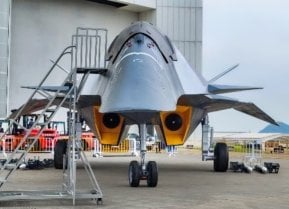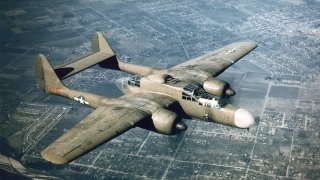P-61 Black Widow: Best WWII Fighter to Ever Fly?
The Northrop P-61 Black Widow was the U.S. Army Air Force’s first dedicated night-fighter, featuring innovative radar technology. With its twin-engine, twin-boom design, the P-61 excelled in nighttime combat during WWII, shooting down 127 aircraft, including 18 V-1 buzz bombs.
What You Need to Know: The Northrop P-61 Black Widow was the U.S. Army Air Force’s first dedicated night-fighter, featuring innovative radar technology. With its twin-engine, twin-boom design, the P-61 excelled in nighttime combat during WWII, shooting down 127 aircraft, including 18 V-1 buzz bombs.
-It was famed for its "Jet Black" finish, making it nearly invisible to enemy searchlights. Notably, Lady in the Dark scored the war’s final two kills.
-The P-61 had a three-person crew and powerful armament of cannons and machine guns. Today, four Black Widows survive in museums across the U.S. and China, preserving its legacy as a groundbreaking aircraft.
P-61 Black Widow: America’s First Radar Night-Fighter That Changed WWII
Though only 706 Northrop P-61 Black Widows were produced, and it only saw service in the final year of the Second World War, the aircraft was notable for being operated effectively as a night-fighter by the United States Army Air Force squadrons in the European, Pacific, China-Burma-India and Mediterranean Theaters of operation.
After the war, it was redesignated the F-51 and served in the United States Air Force as a long-range, all-weather, day/night interceptor for the Air Defense Command until 1948, and later with the Fifth Air Force. It was finally retired in 1954 – yet, it remains a notable aircraft despite its brief service.
A True Night Fighter
From the design stage, Northrop P-61 Black Widow was a creature of the night. The large, powerful, twin-engine aircraft was the first American combat plane designed as a night-fighter/all-weather interceptor – an aircraft adapted for use at night and in times of poor visibility.
While the concept did date to the First World War, when some aircraft were modified to operate at night, it wasn't until the nighttime bombing raids over Europe's cities that military planners saw a need for a specially built aircraft.
P-61: Bat-Like Powers
The all-metal, twin-engine fighter with a twin-boom configuration was similar in profile to the German Focke-Wulf Fw 189 Luftwaffe reconnaissance aircraft and, of course, the American Lockheed P-38, but unlike those planes, the P-61 had an advantage in the evening hours. It was first aircraft designed to use radar.
However, the design and development of the P-61's SCR-720 search radar, which was placed at the front nose of the fighter, reportedly involved 172,000 man-hours of work.
The initial production models were fielded with a U.S. Army regulation olive drab/neutral gray paint scheme, but after testing a "Jet Black" paint on bare metalrather than over existing paint it was found that the plane could be nearly invisible to enemy ground-based searchlights. From February 1944 all the Black Widows were thus painted Jet Black, while those in the field were often repainted.
While the aircraft arrived late in the war, the P-61 Black Widow proved to be a deadly foe in the dark and was able to invisibly approach Japanese aircraft and blast them from the sky.
It scored its first "kill" on July 6, 1944 when a P-61 shot down a Japanese Mitsubishi G4M "Betty" bomber in the Central Pacific.
Three-Person Crew
Unlike other fighters of the era, the P-61 was a large, beefy aircraft that had a crew of three that included a pilot, gunner, and radio operator. The P-61 was also well-armed for its night-fighter role and included four .20 mm Hispano M2 cannons mounted in the lower fuselage, and four .50 caliber M2 Browning machine guns mounted in the dorsal gun turret.
During its short time in service, the aircraft was responsible for downing 127 aircraft including 18 V-1 Buzz Bombs.
One particular P-61, Lady in the Dark, piloted by Captain Lee Kendall, was reportedly one of the most photographed Black Widows in the Pacific Theater, and also was the aircraft that scored the final two aerial "kills" of World War II. One was on the last night of the war, while another was almost 24 hours after the hostilities had officially ended. Kendall was able to down two Japanese aircraft, likely planning kamikaze attacks, by pursuing those enemies and without firing shot caused both to crash!
Surviving Examples
Today there are just four surviving P-61 Black Widows, including three in the United States, while a fourth in the Beijing Air and Space Museum at Beihang University in Beijing, China. That particular aircraft was reportedly taken by Communist Chinese forces at the end of the Second World War.
The others are at the Mid-Atlantic Air Museum in Reading, Pennsylvania; at the Steven F. Udvar-Hazy Center of the National Air and Space Museum in Chantilly, Virginia; and at the National Museum of the United States Air Force at Wright-Patterson AFB in Dayton, Ohio.
About the Author: Peter Suciu
Peter Suciu is a Michigan-based writer who has contributed to more than four dozen magazines, newspapers and websites. He regularly writes about military hardware, and is the author of several books on military headgear including A Gallery of Military Headdress, which is available on Amazon.com. Peter is also a Contributing Writer for Forbes.
All images are Creative Commons.


